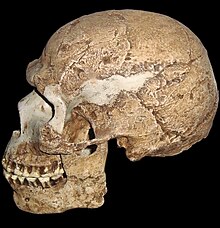From Wikipedia, the free encyclopedia
Biorobotics is a term that loosely covers the fields of cybernetics, bionics and even genetic engineering as a collective study.
Biorobotics is often used to refer to a real subfield of robotics: studying how to make robots that emulate or simulate living biological organisms mechanically or even chemically. The term is also used in a reverse definition: making biological organisms as manipulatable and functional as robots, or making biological organisms as components of robots.
In the latter sense, biorobotics can be referred to as a theoretical discipline of comprehensive genetic engineering in which organisms are created and designed by artificial means. The creation of life from non-living matter for example, would be biorobotics. The field is in its infancy and is sometimes known as synthetic biology or bionanotechnology.
In fiction, biorobotics makes many appearances, like the biots of the novel Rendezvous with Rama or the replicants of the film Blade Runner.
Biorobotics in Fiction
Biorobotics has made many appearances in works of fiction, often in the form of synthetic biological organisms.Augmentations feature as a major plot device in Deus Ex and its prequel Deus Ex: Human Revolution, with nano and mechanical variations, respectively. The advent of such augmentation that is conducive to previously inhuman feats results in widespread civil unrest, fundamentally challenging the self-perception and identity of humanity.
The robots featured in Rossum's Universal Robots, the play that originally coined the term robot, are presented as synthetic biological entities closer to biological organisms than the mechanical objects that the term robot came to refer to. The replicants in the film Blade Runner are biological in nature: they are organisms of living tissue and cells created artificially. In the novel The Windup Girl by Paolo Bacigalupi, "windups" or "New People" are genetically engineered organisms.
The word biot, a portmanteau of "biological robot", was originally coined by Arthur C. Clarke in his 1972 novel Rendezvous with Rama. Biots are depicted as artificial biological organisms created to perform specific tasks on the space vessel Rama. This affects their physical attributes and cognitive abilities.
Humanoid Cylons in the 2004 television series Battlestar Galactica are another example of biological robots in fictions. Almost undistinguishable from humans, they are artificial creations created by mechanical cylons.
The authors of the Star Wars book series The New Jedi Order reprised the term biot. The Yuuzhan Vong uses the term to designate their biotechnology.
The term bioroid, or biological android, as also been used to designate artificial biological organisms, like in the manga Appleseed. In 1985 the animated Robotech television series popularized the term when it reused the term from the 1984 Japanese series The Super Dimension Cavalry Southern Cross.
The term reploid, or replicate-android, is used in the Capcom video game series Mega ManX. Much like Blade Runner's replicants these beings are more human in thinking and emotional awareness then previous generations, despite some being made into animal shapes to purposely distinguish them from humans. Another further future form of these robots, seen in Mega Man Zero, have them being so close to humans that they can actually eat, sleep, and reproduce. The only thing setting them apart is their semi-inorganic skeletal systems. In another farther flung future version and evolution of these bio-machines in the series Mega Man ZX humans and robots have merged seemingly so closely they are no longer a separate race but in-fact two parts to a whole new race. The final future of the game series is Mega Man Legends where humans and robots are one being to the point they can actually get together and reproduce offspring without effort.
In Warhammer 40k Imperium (Warhammer 40,000) uses servitors, vat-grown humans with cybernetic parts replacing most parts of the body.They lack emotions or intelligence and are only capable of simple tasks. A more advanced imperial robots are used by the imperium, instead of using humans they are mostly machine and has biological brain and some other biological parts. Unlike servitors they are capable of having programmed instincts when killing but still they lack any true intelligence.
